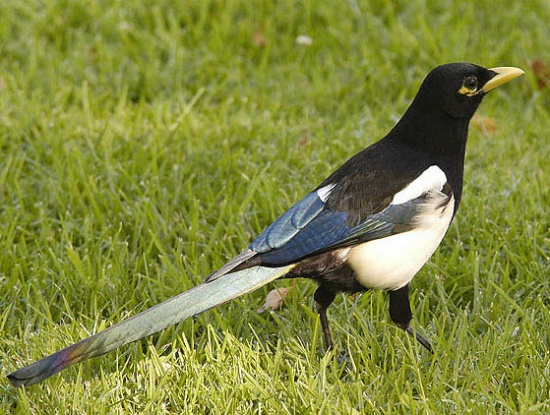- Pica nuttalli
Identification
16-18" (41-46 cm). A slightly smaller version of Black-billed Magpie, but with yellow bill and bare yellow area of skin behind eye. Large white wing patches and long, wedge-shaped, iridescent greenish-black tail. Juvenile has blackish beak and lacks bare face patch. Ranges of two magpies do not overlap.
Distribution
Resident in California's Central Valley and adjacent foothills.
A restricted-range species, prior to 2004 locally common or abundant. The West Nile virus has reduced the population by around 50%.
Taxonomy
This is a monotypic species.
It's closely related to Black-billed Magpie and may even be conspecific with the latter.
Habitat
Oak savannas, oak woods, riverside growth, ranches, and suburbs.
Behaviour
A colony of Yellow-billed Magpies lives communally year round, feeding, socializing, and collectively mobbing predators. This magpie has found in vacant city lots and weedy storage yards a substitute for habitats it lost to intensive agriculture. It has become a city bird but keeps away from places where people gather.
Diet
Omnivorous. Feeds on insects, mice, bird eggs, nestlings, small reptiles, carrion (especially roadkill) and human handouts.
Vocalisation
A raucous qua-qua-qua and a querulous quack.
Breeding
Breeding season from December to May. 5-8 blotched, olive green eggs in a large, domed stick nest; breeds in colonies in tall trees usually so overgrown with mistletoe that it is often hard to detect the nests.
References
- Clements, JF. 2008. The Clements Checklist of Birds of the World. 6th ed., with updates to December 2008. Ithaca: Cornell Univ. Press. ISBN 978-0801445019.
- Del Hoyo, J, A Elliott, and D Christie, eds. 2009. Handbook of the Birds of the World. Volume 14: Bush-shrikes to Old World Sparrows. Barcelona: Lynx Edicions. ISBN 978-8496553507
Recommended Citation
- BirdForum Opus contributors. (2025) Yellow-billed Magpie. In: BirdForum, the forum for wild birds and birding. Retrieved 14 May 2025 from https://www.birdforum.net/opus/Yellow-billed_Magpie




